What are the pests of dill: photos and fight against them, diseases and preventive measures to protect the crop
According to most gardeners, dill is a problem-free plant: it does not need additional feeding and special care, and natural precipitation is perfect for watering. But this is far from the case. Improper care can cause plant diseases. Insects are also a threat, which, along with vegetables and fruits, are not averse to feasting on this fragrant plant.
To get a good dill harvest, we advise you to familiarize yourself with the diseases and pests of this crop, ways of dealing with them and measures to effectively prevent them.
The content of the article
Types of pests of dill
Despite its high resistance to diseases and unpretentious cultivation, the aromatic herb is susceptible to attacks by many parasites that can completely destroy dill beds.
Pests are divided into two types: damaging the underground (root) or aboveground part of the plant.
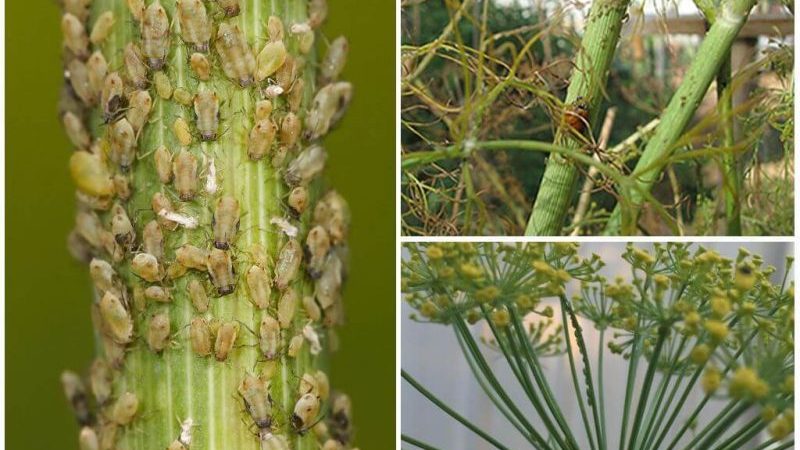
Affecting the root system
Dill shoot roots are dangerous:
- bear;
- wireworm;
- caterpillars;
- beetle larvae.
Striking the top
List of aboveground parasites:
- carrot flap;
- aphid;
- thrips;
- umbrella blind man;
- ruled bratwurst;
- leafhoppers.
What pests threaten dill
There are no pests that prefer exclusively umbrella crops. But in the garden or in the greenhouse there are many insects that can spoil dill crops along with other crops. Consider pests of dill, photos and measures to combat them.
Caterpillars
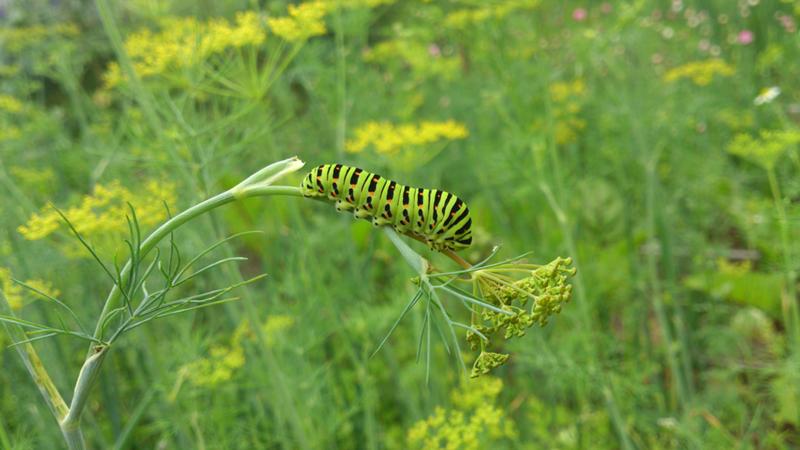
Frequent inhabitants of dill crops. Any caterpillar on a plant is the developmental cycle of a parasitic butterfly.
Larvae are often observed on the harvest:
- Aniseed sailfish butterfly... Black and yellow stripes alternate on each segment of the trunk. It feeds on the leafy parts of the plant.
- Machaon butterflies. The caterpillar has a bright light green color, with black and orange blotches on each segment. A rather gluttonous creature.
For the timely detection of pests, the crop is inspected several times a week. The presence of sticky sap, cobwebs, and deformed leaves indicates the appearance of caterpillars.
How to save crops if the use of chemicals can lead to food poisoning? The use of biological products "Biostop", "Leptocid", etc. is suitable. A more harmless way is manual collection of leaf beetles.
For reference. Useful insects can also settle in the beds. Ladybugs will help gardeners to destroy aphids, and wasps - to cope with butterfly larvae.
Medvedki

Also capable of causing damage to crops. They prefer to eat tubers of radish, potatoes, radish, but in search of food they do not neglect other plants in the garden. Dill often suffers. The insect adapts to any conditions, so the fight can be long and difficult. The primary measure and the main method of pest control is the use of chemicals.
Aphid
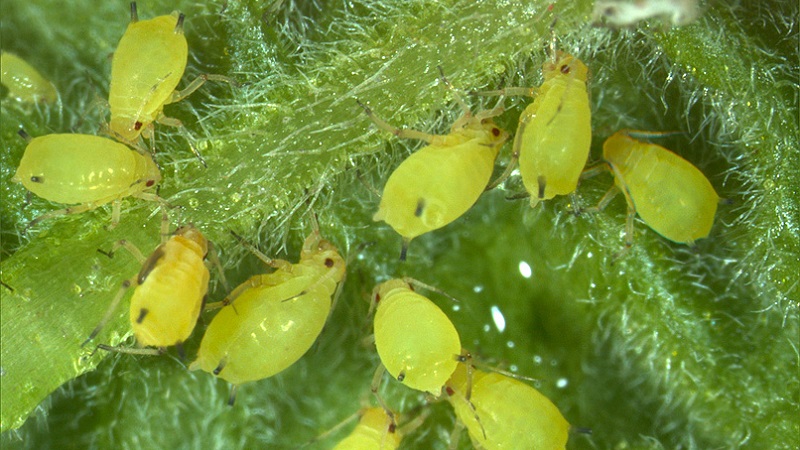
Almost omnivorous insects that infect any vegetation... They settle in large colonies, feed on plant sap. They do not represent a significant health hazard, since they are not poisonous, but they can destroy the entire planting.
You can fight insects with folk remedies. The body of the aphid is covered with a translucent shell, due to which even the weakest means easily penetrate inside and have a destructive effect on the pest.
Popular with gardeners spraying infusions of tobacco or potato tops. 200 g of crushed tobacco leaves are poured into 2 liters of water, infused for 20-24 hours. Then filter and add 10–20 g of grated laundry soap. Treat planting in the morning and evening.
Important! Before eating, the plant is thoroughly washed with running water.
Dill moth
Also known as aniseed, carrot, or umbrella. It is a small butterfly with dull brown wings. The adult lays eggs on the plant and in the soil. The main damage to the plant is caused by emerging caterpillars. They are the same color as the adult moth, with green spots between body segments.
The larvae settle in umbrellas, braiding and pulling them together with cobwebs. Caterpillars feed on buds and flowers, young seeds.
Affected areas of greenery are easier to destroy than to treat. To protect the garden from adults, it is recommended to plant rosemary, calendula, sage or other flowers with a pronounced pungent aroma that can repel moths on the site.
Also, as a preventive measure, you can install homemade traps (cardboard smeared with honey or petroleum jelly) or Velcro for flies on the garden bed.
It is also possible to scare off adults with the help of the preparations “Entobacterin” or “Lepidocide”.
Bedbugs
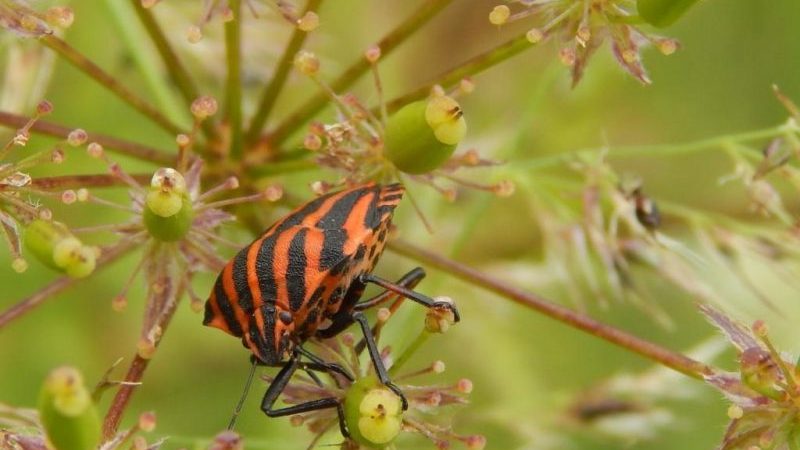
The Italian bug loves to settle on dill. There is also the name striped scutellum, or striped grafosome. Adults hibernate on plant debris and become active in early April. Throughout the warm period, larvae are produced, which, like adults, harm the crop by feeding on plant sap.
Bedbugs during the mating period settle on the top of the dill, which makes it easier for gardeners to fight. To eliminate pests, just brush them into a bucket of water.
Beetle leaf
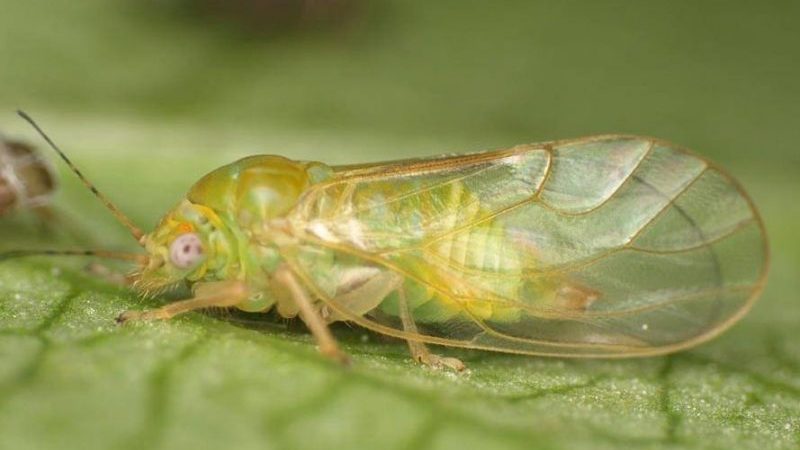
Sometimes called the grass flea, it is a small midge with red eyes, filamentous antennae and transparent wings. Insects are dangerous to crops at all stages of their development. They prefer to settle on young plants, feed on sap from petioles and leaves. As a result, the greenery stops growing and dries up.
It is better to initially prevent the appearance of insects than to fight them in the future. In places where dill is grown, there should be no coniferous plantings and wild carrots. It is important to remove weeds in a timely manner or use a covering material (lutrasil or spunbond), loosen the soil.
If preventive measures have not been taken and the beetle attacked the crop, the dill is treated with orange peel infusions or tobacco broth: pour 1 kg of tobacco with 10-12 liters of warm water, leave for 24 hours, add soap and spray the beds.
Carrot fly
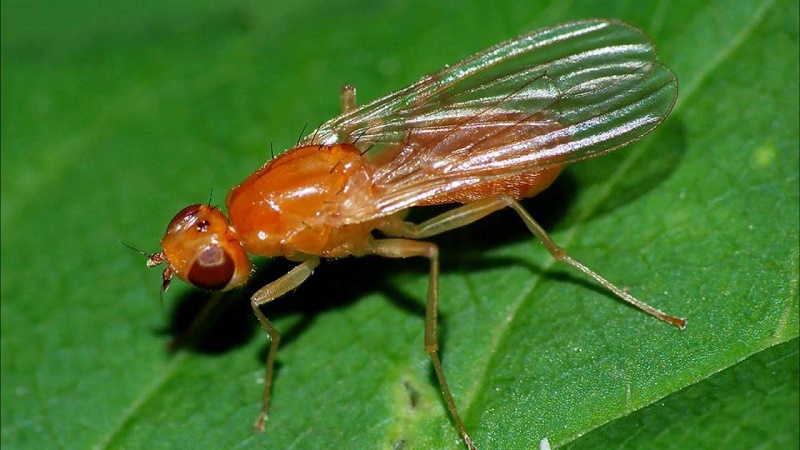
A dangerous and prolific pest for umbrella crops, which is completely impossible to get rid of. Compliance with preventive measures, crop rotation rules will reduce the population.
Due to its small size, the fly is difficult to notice - its length does not exceed 4.5 mm. The appearance of reddish-purple spots on the leaves, their yellowing and dying off indicates a pest attack.
Planting garlic or onions on the site will scare away a fly - it does not tolerate a sharp specific smell.
For prevention, dill beds are irrigated with an infusion of red or black pepper, a solution of onion peel.
Cicadas
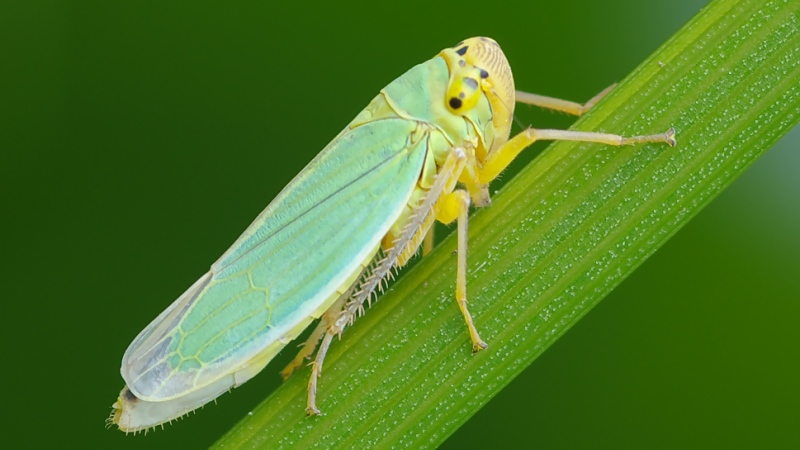
They look like butterflies of small size (up to 5 mm), white. Both adults and larvae cause harm. They feed on plant sap. If brown spots appear on the crop, shoots dry out, it's time to fight pests.
Even more often on the beds there is a leafhopper Slobbery penny. The name of the insect is due to the release of white foam, in which the larvae develop. It looks like a brown or yellowish-dirty butterfly, 1 cm in size. Loves a humid environment and greenhouses.
In the fight against insects, a solution of laundry soap, onion or garlic infusion is effective. To prepare soap, dissolve 300 g of soap in 10 liters of warm water. For a garlic or onion infusion, you need 250 g of chopped vegetable per 1 liter of water. Then it is infused for 7-10 days in a closed container, after which it is diluted with water in a ratio of 1:50 and the plantings are processed.
Thrips
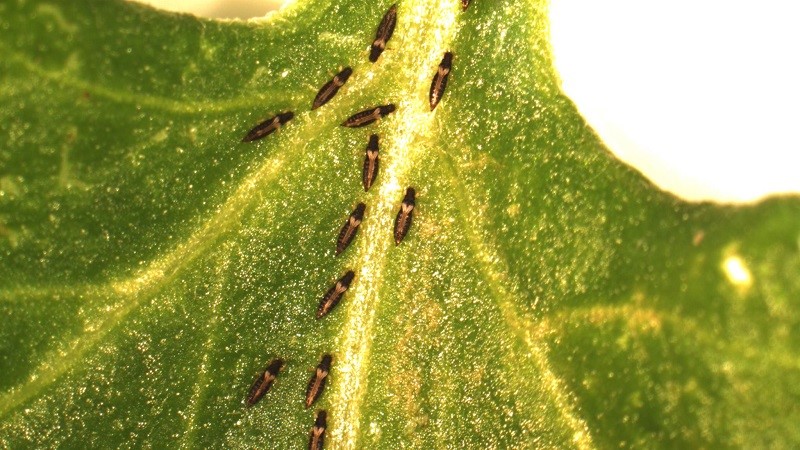
Insects are small in size with an elongated body, so they are hardly noticeable... They feed on cell sap on the leaves and flowers of plants. The key to success in the fight against insects is their timely detection.
Since dill does not lend itself to heat treatment before use, the use of insecticides is undesirable. You can try to fight thrips with folk remedies - a decoction of celandine, tobacco, bitter pepper. Many gardeners use sticky traps.
Read also:
How to deal with the most dangerous pests and diseases of corn?
Fast and effective pest control - pepper slugs.
We save the tomato crop on our own - tomato pests in the greenhouse.
How to deal with them
There are several ways to control insects. One of the safest options is to use Fitoverma. It is a broad-spectrum biological agent. The processed crop can be eaten after 24-30 hours.
Chemicals
When growing umbrella crops for human consumption, it is prohibited to use pesticides or any other chemicals. Dill is often used without pre-cooking, which can lead to health problems. Therefore, pesticides are used only on condition that dill is grown for seeds.
But even in this case, insecticides are used with great care and do not abuse treatments.
Traditional methods
Most gardeners prefer to use folk remedies. Natural insecticides include a decoction of potato tops. It contains solanine, which is harmful to most pests.
Infusions of celandine, hot pepper, mustard do not have a toxic effect on the harvest. Popular among gardeners and tobacco greens.
Plants for infusions and decoctions can be prepared in advance and used next year.
It is recommended to process with infusions and decoctions 2-3 times every 6-8 days. With an increased number of pests, you can increase the number of applications until the insects are completely destroyed.
Dill diseases and methods of their treatment
Thanks to the work of breeders, dill has a well-developed immunity to negative external factors. But the plant has no absolute protection against disease. Various factors contribute to the development of spicy grass diseases, ranging from the thickening of the beds to an illiterately chosen planting site.
Diseases are conventionally divided into:
- spread by pests (phomosis, cercosporosis, verticillary wilting);
- resulting from improper care (powdery mildew, rust fungus, peronosporosis, black leg, fusarium).
Observance of simple preventive measures will allow you to avoid problems with crop diseases, save time and effort for the gardener.
Fomoz

Fungal disease that develops due to high humidity or heat. It can also occur due to a lack of boron in the soil. In most cases, the fungus is active on the aerial part of the plant, the roots are rarely affected. It appears as dark elongated spots with small blotches of black.
Treatment of the affected areas of the plant is useless, the dying parts are removed. The rest of the crop is sprayed with Bordeaux liquid, the soil is disinfected.
Cercosporosis
It develops as a result of the activity of a pathogenic fungus, inhibits the development of the plant. It occurs due to high humidity and at cool air temperatures.
It appears as small brown spots with a brown edging. They quickly increase in size, the plant rots and dies. With cercosporosis, copper oxychloride or Bordeaux mixture helps.
Verticillary wilting
Rarely affects dill, more often found on root crops and berry bushes. Due to the plaque on the plant, most gardeners confuse this disease with spider mite infection.
Other signs of verticillosis include:
- loose root system;
- drying of the lower leaves;
- stop in development;
- the appearance of a red tint on the leaves.
Treatment is useless - there is no cure for verticillosis. As a preventive measure, you can treat the bed with "Previkur". During the active growing season, plantings are irrigated with "Fitodoctor", "Fitosporin-M".
Important! The peculiarity of verticillary disease is a long incubation period (more than two years). The pathogen develops in the soil and does not manifest itself in any way. The soil should be disinfected every fall.
Powdery mildew
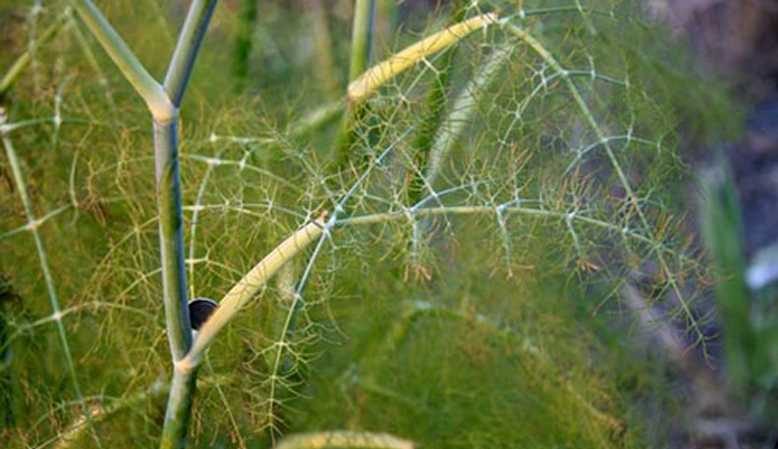
The most common fungal disease. It develops at a humidity of 70% or more, at an air temperature of + 17–20 ° С. Spore carriers are aphids, ants and other insects.
The main symptom of powdery mildew is the appearance of a white coating on the plant in which the spores are located. Over time, the plaque thickens, its color changes to dark brown. The affected areas die off, the dill itself loses its taste and its characteristic aroma.
Pollination of the crop with sulfur will prevent the occurrence of fungus. With single lesions, the plants are removed. The rest of the plantings are treated with copper-containing agents or potassium permanganate. Some gardeners prefer to treat dill with a solution of antibiotics: 2 g of terramycin, penicillin and streptomycin per 1 liter of water.
Rust fungus
The incidence of rust fungus in plants occurs in June... It manifests itself in brown-yellow spots. Treatment with Bordeaux liquid (1%) helps, at intervals of three times a month.
As a preventive measure, the seeds are soaked in hot water before planting, then in cold water and thoroughly dried.
Peronosporosis
Another name for the disease is downy mildew.... It is recognized by yellow spots on the outside of leaves, shoots, umbrellas. Over time, the color changes to brown. A whitish coating appears on the seamy side. The plant dries up and decays. Among the favorable conditions for the development of the disease, irrigation with cold water is noted.
To fight in advanced cases, biological preparations are used: "Fitosporin-M", "Baylon", etc. In the absence of the effectiveness of these means, gardeners treat the plantings with insecticides "Oksikhom" or "Acrobat MC", but then it is prohibited to eat this dill for at least 30-40 days.
To protect the beds from peronosporosis, crushed chalk or sifted wood ash is used - sprinkle both soil and plants.
Blackleg
Basically, the disease appears on young seedlings and in most cases the gardener himself is to blame for this, abundantly and often watering the beds.
Signs include rotting of the root collar, blackening and drying out of dill. At the first manifestations of the disease, watering is reduced to a minimum. Each time, you should add several crystals of potassium permanganate to the water. After watering, the soil is carefully loosened to avoid stagnation of moisture in it.
For treatment, the soil and plants are sprayed with solutions of “Baktofit”, “Fitosporin-M”, or granules of “Glyocladin” or “Trichodermina” are added to the soil.
Of the folk methods, treatment with an infusion of onion husks or wood ash is effective.
Fusarium
Fungal disease is considered quite dangerous. The causative agent saturates plant tissues with a poisonous substance. It appears on the lower leaves, then goes to the upper ones.
Greens acquire a red and yellowish tint, watery spots appear. In advanced cases, the plant withers completely. With a massive infection, the crop is destroyed. At the initial stage, “Vitaros”, “Fitolavin” help.
Important! To prevent the disease from spreading throughout the site, the infected plants are burned.
Watering the soil weekly with a pale pink solution of potassium permanganate will help prevent fungus.
It is interesting:
Why does powdery mildew appear and why is it dangerous on cucumbers?
Prevention measures
To avoid diseases and pests, follow the rules for growing umbrella crops. We also recommend taking preventive measures:
- Clean the area from fallen leaves and plant debris.
- Dig up the soil for the winter.
- Observe the rules of agricultural technology.
- Remove weak and diseased plants.
- Timely respond to the appearance of pests.
Attracting birds and beneficial insects to the garden plot will prevent the appearance of pests. Helpful helpers are attracted by coriander or parsnips, feeders or nests are installed for birds.
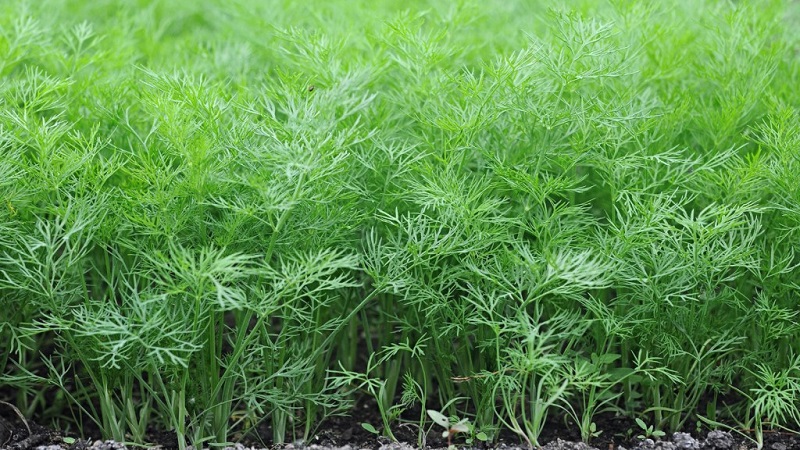
Common questions
Here are some frequently asked questions from novice gardeners. And seasoned summer residents may face similar situations.
Striped beetles on dill - who are they and how to fight?
These are Colorado beetles that winter in the soil. Especially dangerous during flowering and budding of plants. The main harm is caused not by the beetles themselves, but by their larvae. To protect the future harvest and the death of beetles in winter in the fall, they dig up the soil.
In the spring, bugs and larvae are removed by hand into a container with kerosene or a concentrated solution of sodium chloride. In case of a critical infestation of pests, it is worth treating the plantings with special preparations.
What if the dill turns black?
Often gardeners ask: why does dill turn black? This is the first sign of phomosis. The affected areas are removed - they can no longer be saved. The remaining crop is treated with Bordeaux liquid and the frequency of watering the beds is reduced.
What do the black dots on dill mean?
Black dots on a plant are a symptom of phomosis, as is plant blackening. Dark oblong spots with black blotches indicate the activity of the fungus in the garden.
Why do dill leaves turn red?
One of the reasons for the appearance of a brown color on a dill crop is a dense planting. Due to excessive planting density, the plant weakens. The beds must be thinned out and subsequently loosened the soil in a timely manner. A weak borax solution as a plant feed will help avoid redness.
Dill can also turn red due to acidic soil.
For reference. Soil acidity is determined using litmus indicator paper.
Another reason is aphids. Take a closer look at the harvest - you may find small insects on the leaves.
Dill leaves turn red as a result of a physiological process - in the fall, when the temperature drops at night.
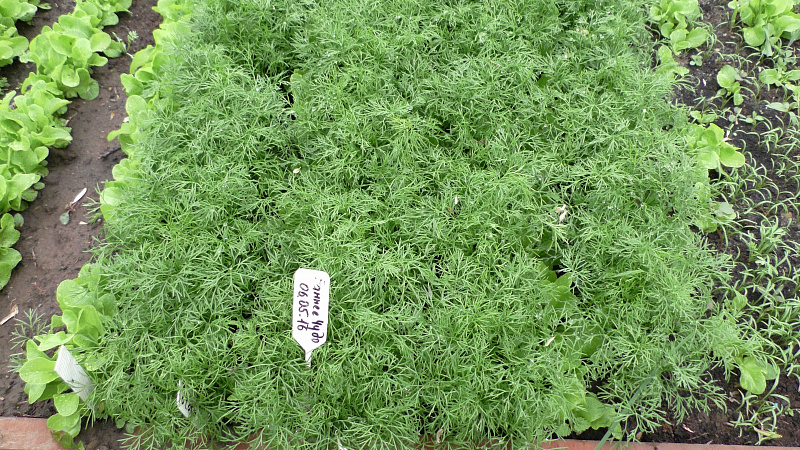
Conclusion
Although dill is considered an unpretentious plant, it, like other plantings of garden plots, is susceptible to disease. Pests do not bypass the spicy grass: the root and aerial parts can be affected by various insects. To get a healthy harvest, follow the basic rules of plant care, regularly inspect the crops. In case of infection, now you know how to process the plantings.
When the first signs of damage are found, preference should be given to folk methods of struggle - this will allow you to confidently use the herb for food. If chemical insecticides have been used, wait 30–40 days. Every experienced gardener knows that it is better to prevent a problem than to deal with it. Simple preventive measures will help prevent crop damage from diseases and pests.